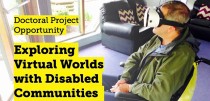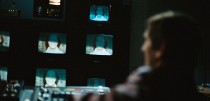According to family folklore, as a toddler I’d sit in front of my mum’s washing machine and watch her colourful garments spin round and round. I don’t have much recollection of this twee scene but I guess from an early age I demonstrated an interest in the ‘moving image’, in all its strange forms.
I grew up glued to the TV, particularly American cartoons funded by toy manufacturers to flog their products, and playing a lot of video games that didn’t do me any harm. However, cinema was, and will always be, my first love.
Our local cinema was the mythical ABC Muirend Cinema. Designed by William Bereseford Inglis in 1933, the building exterior replicated a Spanish style hacienda while inside the auditorium had lots of Flamenco style motifs, such as balconies, amber lanterns and images of matadors painted on tiles dotted along the stairwells. Looking back as I write this, Muirend Cinema seems a bizarre prophecy of my future; I studied Spanish at Glasgow University and somehow I’ve ended up working for Glasgow Film Theatre as Learning Projects Coordinator for Young People. The range of the films it offered were the standard box office fare but I relished them all regardless. My seminal movie moments included watching Jurassic Park on the opening weekend, my mum convincing the box office grump that I was old enough to watch The Man Without A Face and stuffing my face with the cheaper sweets bought next door in Safeways to the bombast of Independence Day.
Sadly like a lot of old cinemas in Glasgow, ABC Muirend shut down in 2001 due to shrinking audiences that preferred the industrial comfort of a multiplex and the cost of maintaining a building that was well past its prime. Each time I pass it, I can’t help feel a wave of sadness for an important community relic that now functions as luxury apartments for a select few. My memories of Muirend remain but families in the Southside of Glasgow have to travel elsewhere these days for their cinematic outings.
Hopefully some of these families come to the GFT for our free Take 2 family screenings which screen every Saturday morning. I try to programme a range of films that appeal to a wide audience while sneaking in a few classic and foreign gems, like The Boy From Mercury, Mr Hulot’s Holiday and The Belles of St. Trinian’s. Unfortunately a lack of distribution of foreign titles for children and availability of prints makes screening non-Hollywood films a lot harder than it should be.
Although 41% of 15-24 year olds visit the cinema once a month* and are exposed to moving images on a daily basis, young people are often the least catered to by art house cinemas. More often than not, they tend to select films that appeal to older audiences with their youth remit left solely to ‘parent and baby’ screenings. Consequently, children and young adults miss out on the wealth of different contemporary perspectives offered by world cinema and so remain quite happy to settle for whatever is showing at their local Cineworld.
This isn’t helped by the fact that moving image education still struggles to be implemented across schools in the UK. Despite repeated efforts, teachers cite a lack of resources and adequate training to properly implement film into the classroom. As a result, DVDs can often become a babysitter for pupils rather than a key part of their cultural development and awareness. It remains to be seen whether the ambitions of 21st Century Literacy, a consortium set up by the UK Film Council and Film Education among others, can be achieved.
In response to these issues, GFT Learning set up the Glasgow Youth Film Festival to offer young people a chance to help devise, promote and run their own film festival. Programmed by a worryingly cool bunch of teenagers, GYFF aims to reach out to young Glaswegians through their love of movies while supporting their talents and aspirations. This year almost 7,000 young people attended GYFF events; it was such a refreshing sight to see so many young faces in our cinemas. (Previously, members of our Youth Group told me that they felt unwelcome by older GFT patrons who thought they’d only talk throughout the film.) The response we had was overwhelming and encouraging enough to safely say that there’s a youth audience in Glasgow interested in films from around the globe.
Over the next few years for GYFF, I hope to increase the opportunities for young people to talk to people who work in the moving image industries – not just directors or actors but writers, graphic designers, animators and editors who all make a living from their passion for film, TV and video games. Like the rest of the arts, the film industry remains horribly white and middle class, in spite of the occasional tokenistic scheme for individuals from underrepresented backgrounds. Anyone who aspires to work in this industry is expected to intern for free or live off small bursaries. I had to do this for almost 2 years and I doubt that it will change anytime soon, no matter how legally grey internships appear.
There’s more to young movie fans than a lucrative demographic to market blockbusters to. Exhibitors, distributors, not to mention teachers, should encourage young people to look at moving image in a reflective and creative way rather than be passive observers that we often assume them to be. Thankfully youth film festivals such as GYFF, Discovery and Future Film, alongside the exciting developments promised by 8 1/2 Foundation, demonstrate the growing commitment to future generations of cinemagoers. With the falling costs of HD technology and the increasing ease of distributing films online, I’m hopeful that all young people will continue to be inspired by the flickering images around them – from the glow of a TV, the hum of a projector or even the hypnotic whirl of your mum’s dirty washing.
*According to UK Film Council’s 2009 Statistics Handbook
Images of ABC Muirend taken from Scottish Cinemas site














Comments